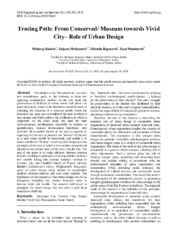Приказ основних података о документу
Tracing Path: From Conserved/ Museum towards Vivid City– Role of Urban Design
| dc.creator | Ralevic, Miodrag | |
| dc.creator | Mrdjenovic, Tatjana | |
| dc.creator | Beganović, Džemila | |
| dc.creator | Muminović, Esad | |
| dc.date.accessioned | 2023-08-18T08:02:04Z | |
| dc.date.available | 2023-08-18T08:02:04Z | |
| dc.date.issued | 2019 | |
| dc.identifier.issn | 2332-1091 | |
| dc.identifier.issn | 2332-1121 | |
| dc.identifier.uri | https://raf.arh.bg.ac.rs/handle/123456789/1313 | |
| dc.description.abstract | The relation to the "historical city" can have two contradictory goals, ie. the tendency to form two opposing contradictory models: on the one hand, the preservation of all levels of values shows and proves its priori historicity, which in the final form manifests itself in obtaining the character of a museum model, where the historical city turns into an exhibit of the time in which it was created and which reflects the civilization in which it originated; on the other hand, the need for their socio-economic development, especially in relation to gentrification, tourism development introduces new activities. Both models should not be seen as separate or opposing, but the way to preserve the "historic" of the city as a base value should be discovered, and enable it to attract and live its "history", evolving and changing on the principles of the time in which it was created, accepted and adapted to the cultural needs of the time it should take. The aim of the paper is to make relations between relevant theories resulting in principles of tracing relation between two models taking into account Landry's concept of Creative city, and Castells's theory of Project identity, Healey's Collaborative theory, Mrdjenovic's Integrative game of urban design using method of comparative analyses between theories and case study analysis. The hypothesis of the research is that urban design can be an integrative discipline that evokes historical cities to become vivid and livable. The research will result in principles for urban design that can trace a path form museum to vivid city. | sr |
| dc.language.iso | en | sr |
| dc.publisher | Horizon Research Publishing | sr |
| dc.rights | openAccess | sr |
| dc.rights.uri | https://creativecommons.org/licenses/by/4.0/ | |
| dc.source | Civil Engineering and Architecture | sr |
| dc.subject | Historical City | sr |
| dc.subject | Creative City | sr |
| dc.subject | Project Identity Vivid City | sr |
| dc.subject | Participation | sr |
| dc.subject | Game Theory | sr |
| dc.title | Tracing Path: From Conserved/ Museum towards Vivid City– Role of Urban Design | sr |
| dc.type | article | sr |
| dc.rights.license | BY | sr |
| dcterms.abstract | Бегановић, Джемила; Ралевиц, Миодраг; Мрдјеновиц, Татјана; Муминовић, Есад; | |
| dc.rights.holder | Tatjana Mrdjenovic, Ralevic Miodrag | sr |
| dc.citation.volume | 7 | |
| dc.citation.issue | 6 | |
| dc.citation.spage | 286 | |
| dc.citation.epage | 295 | |
| dc.identifier.doi | 10.13189/cea.2019.070603 | |
| dc.identifier.fulltext | http://raf.arh.bg.ac.rs/bitstream/id/4535/CEA3-14813430.pdf | |
| dc.type.version | publishedVersion | sr |

